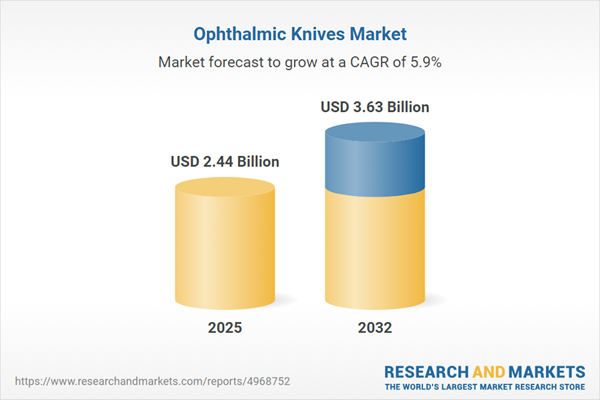Speak directly to the analyst to clarify any post sales queries you may have.
The ophthalmic knives market is defined by ongoing advances in precision, safety, and performance, meeting the needs of evolving surgical techniques and global regulatory requirements. Stakeholders are foregrounding innovation, sustainability, and regional agility to maintain competitiveness.
Market Snapshot: Ophthalmic Knives Market Growth and Trajectory
The ophthalmic knives market grew from USD 2.30 billion in 2024 to USD 2.44 billion in 2025. It is expected to advance at a CAGR of 5.86%, reaching USD 3.63 billion by 2032. This growth is propelled by the increasing adoption of minimally invasive eye surgeries and the introduction of advanced materials and edge geometries across key regions including the Americas, EMEA, and Asia Pacific. Industry participants benefit from resilient supply chains, regulatory clarity, and strong demand for optimized surgical outcomes.
Scope & Segmentation of the Global Ophthalmic Knives Market
This report analyzes detailed segmentation and emerging trends in the ophthalmic knives market:
- Blade Edge: Double bevel, Single bevel – each configuration is evaluated for its impact on incision control and surgical recovery.
- Material: Carbon steel, Stainless steel, Tungsten carbide – each material offers unique cutting characteristics, durability, and procurement considerations.
- Usage Model: Disposable and reusable ophthalmic knives – balancing infection control, cost, and environmental impact.
- Application Areas: Includes procedures such as Femto laser intervention, manual small incision in cataract surgery, phacoemulsification, types of keratoplasty, glaucoma surgeries like trabeculectomy and tube shunt, refractive surgeries (LASIK, PRK, SMILE), and anterior/posterior vitrectomy.
- End User: Ambulatory surgical centers, clinics, and hospitals – differences in purchasing patterns and procedural volumes are analyzed.
- Sales Channel: Direct sales and distribution models – with an assessment of service support, regulatory alignment, and market access.
- Regions Covered: Americas (including North and Latin America), Europe, Middle East & Africa, Asia-Pacific – region-specific dynamics and adoption trends, from established to emerging healthcare markets.
- Leading Companies: Profiles include Alcon Incorporated, Johnson & Johnson Vision Care, Bausch & Lomb, Hoya Corporation, MANI, Moria SA, Diamatrix Ltd., Sidapharm, Corza Medical GmbH, and Ophtechnics Unlimited .
Key Takeaways: Strategic Insights for Senior Decision-Makers
- Technological innovation is driving precise incision capabilities, supported by new coatings and blade designs that reflect collaboration between manufacturers, academia, and clinical end users.
- Emerging regulatory frameworks and stringent safety standards support the consistent quality and traceability of every instrument across global supply chains.
- Stakeholder efforts to address sustainability include adopting environmentally conscious materials and optimizing production efficiency.
- Surgical application diversity is fostering tailored product development, with varying requirements for different procedures, user environments, and healthcare settings.
- Digitalization and data integration, including performance feedback loops from surgeons, are strengthening manufacturer relationships and supporting iterative improvements.
- Competitive differentiation is enhanced by quality management certifications, proprietary blade technologies, and strategic partnerships that accelerate market access.
Tariff Impact on Ophthalmic Knife Sourcing and Supply Chains
Recent tariff changes, especially the 2025 adjustments, have placed upward pressure on component costs, prompting manufacturers to reevaluate their sourcing and production strategies. Moves toward nearshoring and regionalized production aim to strengthen supply resilience and expedite delivery while responding to global uncertainties. Product redesign efforts and alignment of procurement practices reflect evolving duty structures and the pursuit of competitive pricing stability.
Research Methodology & Data Sources
The report’s findings combine secondary research—synthesizing regulatory filings, market analyses, and published literature—with primary insights from structured interviews with surgeons, engineers, and procurement leaders. This multi-layered approach ensures rigorous market validation, accurate trend mapping, and reduction of bias through data triangulation.
Why This Report Matters for Market Leaders
- Delivers actionable segmentation across material, usage, application, and end-user channels, supporting informed product and investment decisions.
- Equips stakeholders with region-specific trends and regulatory analyses essential for navigating tariff impacts and regional adoption pace.
- Supports competitive intelligence on innovation strategies, sustainability efforts, and supply chain agility among global and regional players.
Conclusion
The ophthalmic knives market is evolving through continuous technological, regulatory, and supply chain advancements. Senior decision-makers benefit from a comprehensive view of the forces shaping competition, product development, and global market opportunities.
Additional Product Information:
- Purchase of this report includes 1 year online access with quarterly updates.
- This report can be updated on request. Please contact our Customer Experience team using the Ask a Question widget on our website.
Table of Contents
3. Executive Summary
4. Market Overview
7. Cumulative Impact of Artificial Intelligence 2025
Companies Mentioned
The companies profiled in this Ophthalmic Knives market report include:- Alcon Incorporated
- Johnson & Johnson Vision Care, Inc.
- Bausch & Lomb Incorporated
- Hoya Corporation
- MANI, Inc.
- Moria SA
- Diamatrix Ltd.
- Sidapharm
- Corza Medical GmbH
- Ophtechnics Unlimited
Table Information
| Report Attribute | Details |
|---|---|
| No. of Pages | 196 |
| Published | November 2025 |
| Forecast Period | 2025 - 2032 |
| Estimated Market Value ( USD | $ 2.44 Billion |
| Forecasted Market Value ( USD | $ 3.63 Billion |
| Compound Annual Growth Rate | 5.8% |
| Regions Covered | Global |
| No. of Companies Mentioned | 11 |









